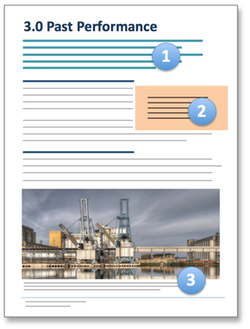Once you understand differentiators and how to develop differentiators with specifics, the next step is using them to maximum advantage in proposals.
Features only you offer and that your prospect cares about can be your winning advantage. Deploy differentiators often in your proposal, keeping in mind that many evaluation teams divide up large proposals, giving each individual one or two sections to read. That means a differentiator needs to be mentioned in every relevant section to score maximum points.
The following are ideal opportunities to use differentiators.
Executive summary
The executive summary is usually the most read section of any proposal—and often the only section read by the decision maker. This is where you lay out your winning strategy—and win strategies are all about differentiation.
Make key value propositions the centrepiece of your executive summary—and take every opportunity to stress features that make your offer superior. Do not hesitate to draw comparisons with your closest competitors (without naming them).
High-impact page components
In addition to embedding differentiators in proposal text, ensure they are always present in these high visibility locations:
 |
Make your differentiators count: Express differentiators where they will have highest impact, including in section summaries (1), capsule statements (2) and visualizations (3). |
Section summaries: These two or three sentence statements explain how your solution satisfies the section requirements. Use a design template that sets off these summaries in large and/or bold face type and places them right after the section title.
Capsule statements: Capsule statements or call-outs are short (8-10 word) sales pitches designed to grab the evaluator’s attention and be memorable. Build each around a key differentiator. Set off capsule statements from body text using coloured text and/or a background tint.
Visualizations: Build visualizations around key differentiators. Examples:
- If your processes are superior, use the cover of a process manual or independent process audit report to make the point—then stress this feature and one or more related benefits (such as consistent service quality) in a selling caption tied to the graphic.
- If you have proven success with projects that align with the bid requirements, use a photo, client logo or other graphic to draw attention to a selling caption that expresses this strength (feature) and ties it to reduced delivery risk and/or better quality (benefits).
Use trigger phrases to signal differentiators
Since most evaluators scan and score proposals, rather than reading them closely, don’t risk having them overlook your differentiators.
Instead, consider beginning a sentence or paragraph expressing a differentiator with a phrase such as “a significant strength our team brings to the project is . . .” or “a unique advantage of this solution is . . .” to ensure reviewers understand the following information may be worth additional points.
Add a checklist to make it easy for evaluators
Build a table of RFP key requirements and how you satisfy each. Include this in the executive summary and/or at the end of each section. Include differentiators in the column where you show how you will address the requirements.
Repetition is OK
Don’t worry about repeating the same differentiator in different sections—or even within a section. Evaluators are looking for reasons to score one bidder higher than another. Don’t disappoint.


